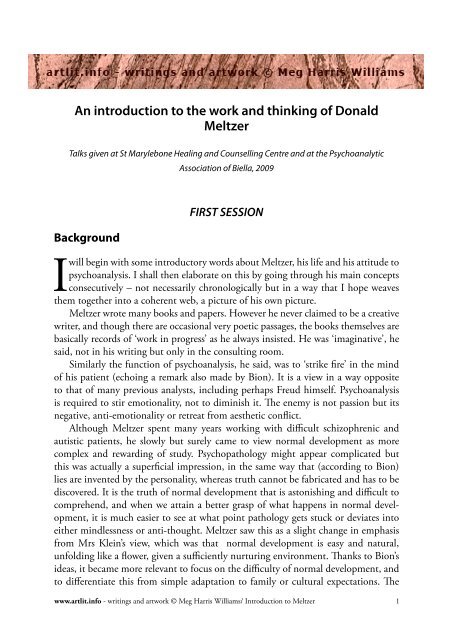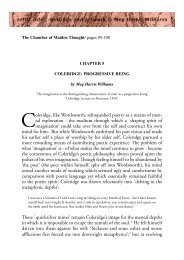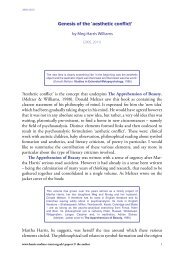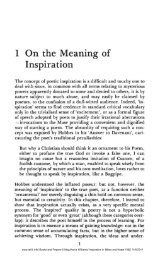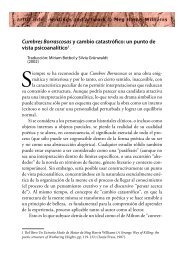An introduction to the work and thinking of Donald Meltzer - Artlit
An introduction to the work and thinking of Donald Meltzer - Artlit
An introduction to the work and thinking of Donald Meltzer - Artlit
You also want an ePaper? Increase the reach of your titles
YUMPU automatically turns print PDFs into web optimized ePapers that Google loves.
Living in <strong>the</strong> genital chamber results in greed, possessiveness <strong>and</strong> miserliness. Livingin <strong>the</strong> rectal chamber results in tyranny – a sadomasochistic situation which causesharm <strong>to</strong> <strong>the</strong> internal babies, likely <strong>to</strong> be reinforced by harm <strong>to</strong> external babies in <strong>the</strong>shape <strong>of</strong> o<strong>the</strong>r people in society.Living in <strong>the</strong> head-breast results in pseudo-maturity. This chamber is in<strong>to</strong>leran<strong>to</strong>f ignorance – it is a substitute for awareness <strong>of</strong> <strong>the</strong> Socratean or Bionic space <strong>of</strong>absence <strong>of</strong> memory <strong>and</strong> desire. <strong>Meltzer</strong> first described this in a paper on <strong>the</strong> ‘delusion<strong>of</strong> clarity <strong>of</strong> insight’. It is a particular danger for <strong>the</strong> psychoanalyst, <strong>and</strong> results in <strong>the</strong>inability <strong>to</strong> trust in <strong>the</strong> process as aes<strong>the</strong>tic object. Although it has similarities withwhat is sometimes called an ‘as if’ personality, it is actually more tyrannical, since itspolitical aim is <strong>to</strong> manipulate o<strong>the</strong>r people. Living in this chamber is liable <strong>to</strong> block<strong>the</strong> capacity <strong>to</strong> view each session as a new situation. It is an impediment <strong>to</strong> observation<strong>and</strong> <strong>to</strong> feeling <strong>the</strong> countertransference. The tiny changes that carry <strong>the</strong> stirrings<strong>of</strong> mental life go undetected in <strong>the</strong>se glaring headlights – <strong>the</strong> opposite <strong>of</strong> what Bioncalls a ‘beam <strong>of</strong> darkness’.Although all <strong>the</strong>se forms <strong>of</strong> psychopathology are wellknown <strong>and</strong> may be dealtwith under <strong>the</strong> traditional heading simply <strong>of</strong> projective identification, it is <strong>the</strong> concep<strong>to</strong>f retreat from aes<strong>the</strong>tic conflict that illuminates <strong>the</strong> illusory quality <strong>of</strong> <strong>the</strong> superficialvitality <strong>of</strong> <strong>the</strong> Claustrum. [something that Bion also constantly stressed - vitalitybeing a necessary requirement for conducting an analysis.] <strong>Meltzer</strong> also maintainedthat <strong>the</strong> door <strong>to</strong> <strong>the</strong> Claustrum was ‘always open’; <strong>and</strong> <strong>the</strong> way out is through engagingwith <strong>the</strong> aes<strong>the</strong>tic conflict. This is equivalent <strong>to</strong> ‘lighting fire’ in <strong>the</strong> patient’smind <strong>and</strong> is <strong>the</strong> analyst’s prime task – not <strong>the</strong> moralistic goal propounded by establishmentKleinian <strong>the</strong>ory, which falls prey <strong>to</strong> adaptation <strong>and</strong> respectability. <strong>Meltzer</strong>wrote that he had not come across any patient who had never had any glimpse <strong>of</strong> ‘<strong>the</strong>dazzle <strong>of</strong> <strong>the</strong> sunrise’.A wonderful illustration <strong>of</strong> this contrast may be found Shakespeare’s King Lear,which sets <strong>the</strong> mania <strong>of</strong> Edmund against <strong>the</strong> apparent passivity <strong>of</strong> Edgar. They representfalse <strong>and</strong> true aspects <strong>of</strong> <strong>the</strong> personality, aes<strong>the</strong>tic versus claustrophobic. Edmundbelieves he is outrageous <strong>and</strong> dynamic because he is illegitimate – which he interpretsas being born <strong>of</strong> a passionate combined object; but his hollowness is revealed. Edgarappears <strong>to</strong> be mad <strong>and</strong> helpless but he is <strong>the</strong> vital force: he fuels <strong>the</strong> steady progression<strong>of</strong> <strong>the</strong> old men, Lear <strong>and</strong> Gloucester <strong>to</strong>wards <strong>the</strong>ir death. Lear is associated with<strong>the</strong> great fire <strong>of</strong> rage; Gloucester with <strong>the</strong> little fire <strong>of</strong> eyesight. Their death is really aform <strong>of</strong> rebirth - Bion’s catastrophic change in<strong>to</strong> a new state <strong>of</strong> being - expressed byEdgar becoming <strong>the</strong> new king.Dream life <strong>and</strong> symbol formationThe great symbolic structure <strong>of</strong> King Lear suggests our route back from <strong>the</strong> Model<strong>of</strong> <strong>the</strong> Mind <strong>to</strong> <strong>Meltzer</strong>’s views on dream life <strong>and</strong> symbol formation. Dreams <strong>and</strong>symbolmaking lie at <strong>the</strong> heart <strong>of</strong> his picture <strong>of</strong> mental vitality. In line with Freud’s ownwww.artlit.info - writings <strong>and</strong> art<strong>work</strong> © Meg Harris Williams/ Introduction <strong>to</strong> <strong>Meltzer</strong> 10
definition <strong>of</strong> psychoanalysis, <strong>Meltzer</strong> once said that <strong>the</strong> only talent he ever discoveredin himself was that <strong>of</strong> reading dreams. ‘The dream is my l<strong>and</strong>scape’ he once wrote ina letter. It is where his interest in psychoanalysis began, continued <strong>and</strong> culminates.<strong>Meltzer</strong> was much interested in <strong>the</strong> philosophy <strong>of</strong> symbol-making, particularly<strong>the</strong> tradition <strong>of</strong> Wittgenstein, Cassirer, Whitehead <strong>and</strong> Langer. This is <strong>the</strong> traditionthat is particularly concerned with <strong>the</strong> distinction between ‘presentational forms’ <strong>and</strong>‘discursive forms’, showing <strong>and</strong> saying - <strong>the</strong> limitations <strong>of</strong> conscious meaning versus<strong>the</strong> richness <strong>of</strong> unconscious meaning. It was in <strong>the</strong> context <strong>of</strong> this tradition that, inDream Life (1983), he said he was trying <strong>to</strong> ‘formulate an aes<strong>the</strong>tic <strong>the</strong>ory <strong>of</strong> dreams’(p. 29) that departed from Freud’s day-residue <strong>the</strong>ory <strong>of</strong> dreams, <strong>and</strong> that wouldbring psychoanalysis more in line with traditional art forms – both <strong>the</strong>ir methodology<strong>and</strong> <strong>the</strong>ir focus on dream-symbols.Individual dreams may vary greatly in <strong>the</strong>ir aes<strong>the</strong>tic quality. However <strong>the</strong>y alwayscontain infinitely more meaning than <strong>the</strong> patient, or <strong>the</strong> analyst, can verbalise. Ofthis aes<strong>the</strong>tic containing power <strong>Meltzer</strong> wrote:It can be seen that a number <strong>of</strong> central formal structures are being drawn up in<strong>to</strong> juxtapositions <strong>to</strong>create a space scintillating with potentiated meaning. Sometimes words <strong>and</strong> visual forms are seen <strong>to</strong>interact… At o<strong>the</strong>r times spaces are being created as containers <strong>of</strong> meaning. At o<strong>the</strong>r times <strong>the</strong> movementsfrom one type <strong>of</strong> space <strong>to</strong> ano<strong>the</strong>r, <strong>and</strong> <strong>the</strong> emotional difficulties <strong>of</strong> making such moves, aremade apparent. (Dream Life 148).Dreams are au<strong>the</strong>ntic manifestations <strong>of</strong> <strong>the</strong> drama <strong>of</strong> part-objects that is <strong>the</strong> stuff <strong>of</strong>psychoanalysis, with aspects <strong>of</strong> <strong>the</strong> internal combined object acting as protagonists ina ‘<strong>the</strong>atre <strong>of</strong> phantasy’ – a key phrase expressing <strong>Meltzer</strong>’s spatial view <strong>of</strong> mental life.(He felt in fact that some analysts had lost <strong>to</strong>uch with Melanie Klein’s own stress on<strong>the</strong> psychic reality <strong>of</strong> <strong>the</strong> part-object figures <strong>of</strong> <strong>the</strong> inner world <strong>and</strong> with <strong>the</strong> psychicspace or spaces which <strong>the</strong>y inhabit).A special feature <strong>of</strong> <strong>Meltzer</strong>’s <strong>the</strong>ory <strong>of</strong> dreams is his view <strong>of</strong> dream-life as a continuum,in which meaning is continuously generated by internal objects, ra<strong>the</strong>r thaninvented by <strong>the</strong> self. Psychoanalysis, he wrote in his book <strong>of</strong> that name, <strong>of</strong>fers a‘privileged sampling’ <strong>of</strong> this most creative level <strong>of</strong> an individual’s mental functioning.Indeed, this is <strong>the</strong> only functioning that is truly ‘mental’; everything else is ei<strong>the</strong>rpro<strong>to</strong>mental (in Bion’s term) or discursive – that is, it ‘says’ ra<strong>the</strong>r than ‘shows’ things,<strong>and</strong> what can be ‘said’ is inevitably much less complex than what can be ‘shown’ indreams or o<strong>the</strong>r symbolic modes such as art forms. Dream-life is <strong>the</strong> place in whichmental growth occurs: ‘growth goes on in <strong>the</strong> quiet chrysalis <strong>of</strong> dream-life’ (p. 177).It occurs (or is stunted) whe<strong>the</strong>r or not we are privileged <strong>to</strong> observe it, <strong>and</strong> whe<strong>the</strong>r ornot we can find a reasonably correct interpretation for <strong>the</strong> dream. In dreams, mentallife happens <strong>and</strong> – as Keats would say – ‘<strong>the</strong> creative creates itself’.Dream life is itself a presentational form, <strong>and</strong> we need <strong>to</strong> receive its manifestationsin a congruent way, through <strong>the</strong> language <strong>of</strong> communication ra<strong>the</strong>r than <strong>the</strong> jargon <strong>of</strong>explana<strong>to</strong>ry diagnosis. For this reason <strong>Meltzer</strong> preferred <strong>to</strong> speak <strong>of</strong> ‘dream exploration’www.artlit.info - writings <strong>and</strong> art<strong>work</strong> © Meg Harris Williams/ Introduction <strong>to</strong> <strong>Meltzer</strong> 11
as aes<strong>the</strong>tic object (first mooted in The Psychoanalytical Process) <strong>and</strong> introduces a conception<strong>of</strong> psychoanalysis as an art form with analogies <strong>to</strong> literary criticism.1990 The Claustrum: an investigation <strong>of</strong> claustrophobic phenomena.Instead <strong>of</strong> life <strong>and</strong> death instincts at <strong>work</strong>, <strong>Meltzer</strong> sees 3 distinct narcissisticworlds in relation <strong>to</strong> phantasies <strong>of</strong> living in a compartmentalised internal mo<strong>the</strong>r.For a full bibliography <strong>of</strong> <strong>Meltzer</strong>’s writings see www.harris-meltzer-trust.org.ukSome <strong>Meltzer</strong>ian conceptsPre-formed transference <strong>and</strong> ga<strong>the</strong>ring <strong>of</strong> <strong>the</strong> transference. Distinguishing <strong>the</strong>true transference (a present relationship) from <strong>the</strong> preconceptions brought by <strong>the</strong>analys<strong>and</strong> - can block communication or seduce <strong>the</strong> analyst. (The PsychoanalyticalProcess.)The <strong>to</strong>ilet-breast. <strong>An</strong> essential function <strong>of</strong> <strong>the</strong> breast as earliest object. (The PsychoanalyticalProcess.)Projective <strong>and</strong> intrusive identification. Distinguishes communicative projectiveidentification (essential <strong>to</strong> development) from pathological attempts <strong>to</strong> control <strong>the</strong>mo<strong>the</strong>r/object. (Studies in Extended Metapsychology).Adhesive identification. Bick’s concept illuminated by <strong>work</strong> with autistic childrenwho ‘dismantle’ <strong>the</strong>ir object; distinct from attacking or intruding in<strong>to</strong> <strong>the</strong> object.(Explorations in Autism).Aes<strong>the</strong>tic conflict. A concept drawn from poetry; seen as <strong>the</strong> key <strong>to</strong> mental development.Instead <strong>of</strong> innate life <strong>and</strong> death instincts is <strong>the</strong> tension between love <strong>and</strong>hate <strong>of</strong> <strong>the</strong> mo<strong>the</strong>r/object, beginning at birth. (The Apprehension <strong>of</strong> Beauty.)Combined object. Observed <strong>and</strong> formulated by Mrs Klein, who saw it as a ra<strong>the</strong>rdark, overwhelming concept; adapted by <strong>Meltzer</strong> in association with Bion’s ‘catastrophicchange’ <strong>to</strong> represent a necessary <strong>and</strong> beneficial developmental force. (TheKleinian Development.)Sexuality. In accordance with Freud, <strong>the</strong> key <strong>to</strong> everything; but <strong>Meltzer</strong> differentiatesperversity from psychosexual exploration, especially in <strong>the</strong> case <strong>of</strong> adolescents,<strong>and</strong> sees unconscious phantasy – not action – as <strong>the</strong> key <strong>to</strong> its meaning. (Sexual States<strong>of</strong> Mind).The Claustrum. <strong>An</strong> expansion <strong>and</strong> elaboration <strong>of</strong> intrusive identification in<strong>to</strong> 3areas <strong>of</strong> <strong>the</strong> internal mo<strong>the</strong>r’s body: genital, rectal <strong>and</strong> head-breast. (The Claustrum).www.artlit.info - writings <strong>and</strong> art<strong>work</strong> © Meg Harris Williams/ Introduction <strong>to</strong> <strong>Meltzer</strong> 15
Pseudo-maturity. The result <strong>of</strong> living in <strong>the</strong> head-breast chamber <strong>of</strong> <strong>the</strong> Claustrum,in<strong>to</strong>lerant <strong>of</strong> ignorance.Tyranny. Sadomasochistic result <strong>of</strong> living in <strong>the</strong> rectal chamber <strong>of</strong> <strong>the</strong> Claustrum.Dream-life <strong>and</strong> symbol formation. <strong>Meltzer</strong>’s view <strong>of</strong> stages in <strong>thinking</strong> (enhancedby Bion’s Grid) is founded firmly on Klein’s drama <strong>of</strong> part-objects (mo<strong>the</strong>r’s or fa<strong>the</strong>r’sbody) acting as protagonists in a ‘<strong>the</strong>atre <strong>of</strong> phantasy’. (Dream Life <strong>and</strong> Studies inExtended Metapsychology).The counter-transference dream. <strong>Meltzer</strong>’s equivalent <strong>to</strong> Bion’s ‘reverie’ – <strong>the</strong>state <strong>of</strong> mind necessary for psychoanalytical <strong>work</strong> when it is a mutual communication,taking place in <strong>the</strong> present. It is based on mo<strong>the</strong>r-baby communication. Notein Meg Harris Williams (2005), The Vale <strong>of</strong> Soulmaking.www.artlit.info - writings <strong>and</strong> art<strong>work</strong> © Meg Harris Williams/ Introduction <strong>to</strong> <strong>Meltzer</strong> 16


